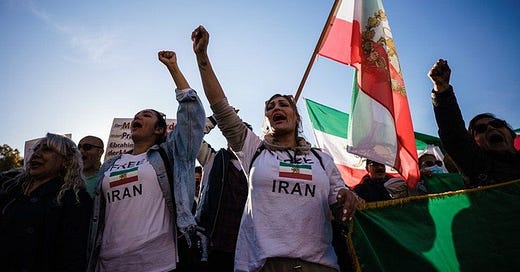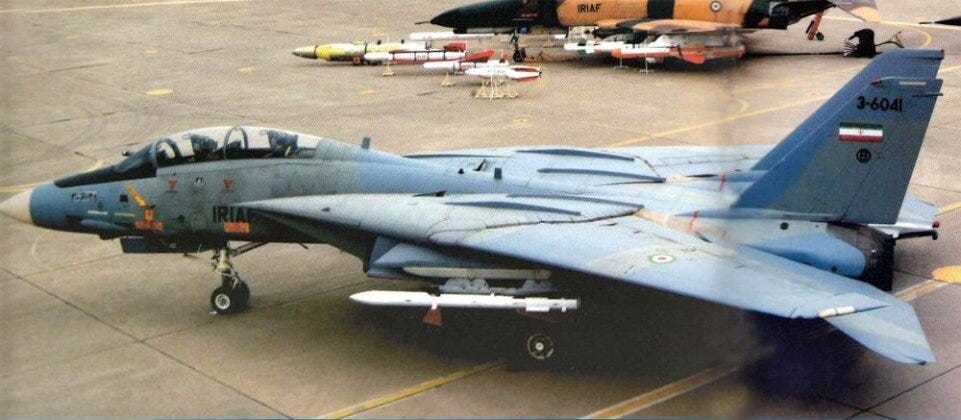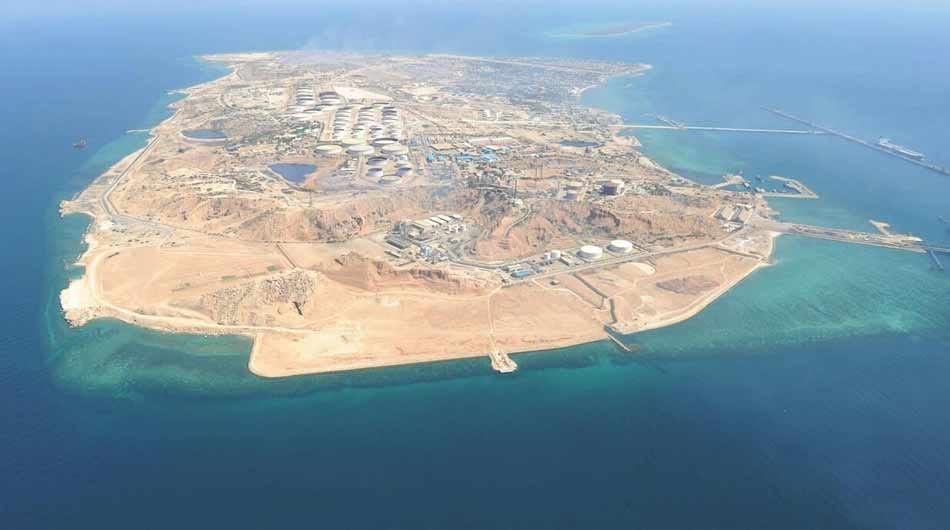Ayatollahs on Life Support
The regime of the Islamic Republic is now more vulnerable than it has ever been in its 45 year existence.
Last night, over 180 hypersonic ballistic missiles were fired from the Islamic Republic of Iran, aimed at targets across Israel. This follows a similar attack back in April. The Supreme Ayatollah Khamenei has said this was in response to the Israeli attacks on Hezbollah in recent weeks, wiping out many of their senior commanders.
There is no doubt that this will lead to an escalation, if not all out war. One could argue we were already there, as the IDF moves ground forces into Lebanon following their air strikes on Hezbollah. In any case, this is a chain of events that could very well lead to the end of the current regime in Iran.
Iranians protesting against the Islamic Republic state. The Golden Lion is a symbol of the former flag, before the 1979 revolution, when the country was led by the Shah. It has since become a major symbol of resistance, particularly on social media.
By all accounts, the Ayatollahs are deeply unpopular among their own people. There have been a number of major and deadly protests that have swept the country in recent decades, from 1999 to 2023. In 2019, an estimated 1500 people were killed by government forces following the largest protests ever seen since the 1979 revolution. In 2022, following the death in police custody of Mahsa Amini, a young Iranian woman for refusing to veil herself, even larger protests occurred, also killing about 550 people. One study by the Dutch-based Gamaan Institute in late 2023, surveying 158 000 people in Iran and 42 000 in the diaspora, found that 80% of respondents rejected the Islamic Republic and would prefer a democratic system of government.
Young people, and young women in particular, have shown hostility towards the regime. Many are unemployed, and many have also suffered directly at the hands of often repressive morality police forces like the Basij and the Pasdaran. It has been said by several geopolitical analysts that the Ayatollahs require a million-man army just to keep their own population in check. There are widespread videos of Iranians, along with many Arabs in Lebanon and Syria, celebrating when news of Hassan Nasrallah's death was announced.
The regime also controls large swaths of the economy, which they have highly centralised. Even without sanctions, the government is highly bureaucratic, bloated and corrupt. Think of something like Russia of Putin and the oligarchs. Only instead of 22 oligarchs, there are 10 000 of them, many of whom live in palaces while most ordinary Iranians suffer poverty and high inflation rates. This also leads to an explosive situation.
Finally, the regime also faces a number of separatist movements, from the Azeris to the Kurds to the Balochis. Back in January, the regime took direct action by striking at supposedly safe havens for the Baluchistan Liberation Army and Baluchistan Liberation front in Pakistan, leading to fears of a wider conflict in the region. There have also been major tensions with the Taliban, particularly over the waters of the Helmand river, as well as history regarding the persecution of the Hazara Shiite minority by the Taliban in Afghanistan. It is said that the Islamic Republic and the Taliban nearly engaged in all-out war, just before 9/11 and the American intervention.
The regime has arguably tried to de-escalate the current situation. Back in April, when Israel struck an IRGC (Islamic Republic Guard Corps) building within the Iranian embassy complex in Damascus, Syria, killing 16 people including 8 senior IRGC commanders, Iran struck back with a missile barrage that was announced several days in advance, including what weapons and flight paths were used. While the regime felt compelled to respond, in what has been known as the geopolitics of saving face in the Middle-East, many saw this as a sign that it sought to avoid all-out war. Not because the Islamic Republic wished to suddenly re-establish relations with Israel, but, it has been argued, because this was a war that the regime could not hope to win.
This is a major problem for Tehran in more ways than one. By having to spend huge amounts of the state and military budget simply to keep both its population and seperatists under control, they have far less money for military innovations. This is not unlike the strategic problems Russia faces, also having a million man conscript army to hold its territory together. Hence why Russian military equipment is often significantly behind its western counterparts.
Likewise in Iran. The Islamic Republic air force is simply not competitive compared to the Israel air force. Many of their jets, symbolised by the old F14 Tomcat purchased before the 79 revolution, are half a century old, and have not received spare and maintenance parts from the US. Contrast this to the F35s and even modern F15s on the Israeli side. This also assumes the United States, Great Britain or a number of Arab states like Jordan and Saudi Arabia would not fight alongside Israel in this all-out war, even though they assisted the Jewish state back in April and seemingly did so again in the latest attacks.
The Iranian F14 Tomcat. 80 were purchased before the 79 revolution. While impressive and not to be underestimated, it is also arguably no match for current 4th and 5th generation Israeli and American fighters. This is symbolic of the problems faced by the Islamic Republic.
The Iranian navy is almost entirely short range patrol boats designed to protect territorial waters. Nothing the regime can threaten Israel with. The army, while a million strong, would also have to move over 1000 miles across the open deserts of Iraq and Syria just to reach Israel, where IDF forces will be waiting, dug-in into strong defensive positions. Many Arab armies have tried to invade Israel in the past and failed. Not to mention that such an army marching across open desert will become a prime target for air strikes, and will leave behind very vulnerable supply lines for air and special forces to hit.
This leaves cyberwarfare, for which the Israelis are some of the best in the world at (they, alongside the Americans, developed the Stuxnet worm that crippled Iranian nuclear enrichment sites) and missile strikes. Israel also has some of the best air-defences in the world, symbolised by the Iron Dome, David Sling and Arrow systems. The Islamic Republic does not. The best they have are the Russian S-400 systems that have proven woefully innefective against Ukraine. This leaves many targets within Iran vulnerable.
For decades, the regime understood this. Their disastrous 8-year war with Iraq in the 1980s, where over a million soldiers died, led to a change of strategy. Instead, they would now fight their enemies indirectly, using proxy forces. This is why they have often trained, funded and equipped militant groups like Hamas, Hezbollah, and Ansar Allah, also known as the Houthis. Gulf states have often followed such an approach as well, funding groups like Al-Qaeda and ISIS.
The problem with proxy forces, as these examples show, is that they cannot be controlled. Proxy groups are like firecrackers that you aim in a certain direction, in the hopes it will hit its target. Otherwise, they can strike all over the place and even backfire against you or your allies. Many in fact have questioned whether the Islamic Republic had any direct role in the October 7th attacks or not, or if this was an entirely planned Hamas attack. Whether they directly did have a role in the attacks or not, the belief which has held for decades has been that if Israel were to ever attack Iran directly, then Hamas and Hezbollah could retaliate on the northern and southern flanks of the Jewish state.
Such status-quo has been shattered since the attacks of last year. Israel may never be able to fully defeat Hamas, since they represent an idea and killing current members will not prevent new members from joining, but the IDF are severely degrading the fighting capabilities of the group in Gaza. They have taken control of the Philadelphia Corridor at the border between Gaza and Egypt, where Hamas used to smuggle virtually all of their weapons. They have been slowly but surely destroying their tunnel networks. Without these, all Hamas can hope to do will be to engage in knife and stone attacks, not unlike how the Palestinians in the West Bank fight today.
Likewise, Hezbollah has been dealt a major blow. Since the pagers that detonated weeks ago were only meant for senior commanders, an estimated 2500-3000 senior members of the Shia militant group have been either killed or severely wounded. After that, a number of missile sites in southern Lebanon have been hit, and, most of all, most of their senior commanders, including Nasrallah himself, have also died. Their capacity to organise and regroup to counter Israel’s ground invasion will be limited.
This means the ayatollahs have lost their northern and southern flanks against Israel, and now have to fight them directly, if only to support such allies and show strength. So to save face and do just this, Ayatollah Khamenei, the current supreme leader of the Islamic Republic, felt compelled to retaliate against Israel and opened fire, but this has probably been a very bitter pill for him to swallow. A part of him certainly knows the consequences of such an attack.
This time, no official warning was provided, except from American intelligence mere hours before launch. This time, rather than use a combination of drones and slow cruise missiles, the regime fired entirely with hypersonic ballistic missiles, in what was clearly attempts at saturating air-defence systems, hoping to cause maximum destruction. Yet the reported damage so far in Israel seems to be minimal.
Regardless, Israel will now almost certainly retaliate. I expect their missile and air strikes to be much more targeted, and aim for major military targets, including possibly the nuclear sites. They may even target Kharg island to deal a major blow to the Iranian economy, not unlike how Ukraine is targeting oil refineries and depots within Russia itself. The necessity for Khamenei to save face may have condemned the fall of his regime very shortly.
Karg Island is a 20 km2 coral island at the very top of the Persian gulf, where 95% of Iranian oil and gas exports leave the country. It is not even connected by a bridge to the mainland, yet has the capacity to export up to 7 million barrels of oil a day. One major air strike on the facilities there and it would wipe out Iranian oil exports for years, likely completely collapsing the economy and the revenue stream of the regime.
Kharg Island, a coral island about 25 kms off the coast of Iran, and where some 90% of Iranian oil and gas exports leave from. Such concentration of resources, for an already very hydrocarbon-dependant regime, makes them incredibly vulnerable.
Why hasn’t this happened yet? The first reason might simply be that Israel does not wish to alienate the people of Iran too much and instead will aim to turn them into a major ally in the region, and so will wish to avoid targeting civilian infrastructure that will be needed to build a new Iran. Beyond that reason is of course the geopolitical one.
Prior to the shale revolution in the United States, oil flows from the Persian Gulf were critical to maintaining relatively low oil prices. The Islamic Republic provides about 10% of global oil supplies, mostly to China. Other major importers are Japan, India and South Korea. Removing the Iranian oil from world markets could have even worse effects as when Russia invaded Ukraine, since not only similar amounts of oil would be lost, but oil traders would bulk at the wider conflict risk in the Middle East threatening Gulf state oil and gas exports.
However, the strategic picture is also very different today. Major oil and gas discoveries have been made in the last ten years, in places like the coastal waters of Cyprus, Israel, Egypt, Turkey, and Senegal. Guyana has now become a key oil exporter, and is scheduled to export 1 million barrels/day by 2026. Saudi Arabia also has the Petroline and IPSA line, pipelines across the country to transport oil and natural gas, respectively, thus circumventing both the straits of Hormuz and the Bab El Mandab straights into the Red Sea. Something the Islamic Republic cannot do.
And of course there is the United States and Canada. The US shale revolution has made the United States the world’s largest oil and gas producer and soon to be largest exporter. They are now the main source of these commodities for the European Union. Not to be undone, Canada is nearing completion of the LNG Canada pipeline and Kitimat liquefaction terminal. Once completed, it will deliver huge amounts of natural gas from the Montney Bassin in the interior to the Pacific coast and onto Asian markets, particularly Japan and South Korea.
Then there is the demand side of the equation. The Gulf states, for better or for worse, are actively moving towards post-oil economies. Not the Islamic Republic. Both the EU and China are investing massively in post-oil transition projects, in part for climate reasons but mainly because of their dependence on oil and gas imports in the wake of the Ukraine war. China is currently building 225 solar and wind bases, each one the size of Central Park in NYC, across their numerous deserts. When completed, these should provide electricity to the equivalent of 400 million homes.
Finally, as the populations of Europe and China likely peak and decline, so will oil and gas consumption. Beyond the age of about 45, people tend to consume less oil and gas, so any increase in the average national age has significant repercussions. One saying I’ve heard is that young parents drive to work and to take their children to school and soccer practice. Older parents simply drive to work. Retirees don’t drive to work at all. Since fewer adults are also having children, the maths quickly adds up. In fact, global peak oil consumption is scheduled for 2030, perhaps even as soon as 2028, according to the International Energy Agency.
This is a very long way of saying that Iranian supply to global oil markets won’t matter all that much long-term, any more than Russia’s. The West has shifted remarkably well and quickly away from Russian crude, no doubt something Vladimir Putin was not expecting. The same may very well be true for the Islamic Republic. An increase in oil prices immediately following such an attack will also potentially benefit rival oil producers in the region like the Gulf States, just like Russia’s invasion of Ukraine did.
The Islamic Republic, however, needs such oil and gas revenues to fund many of their welfare programs to the people, despite the numerous protests. They also need it to fund their million-man army and numerous militias. In the past, when such protests erupted, it was not uncommon for groups like Hezbollah to send fighters to help quell such protests. Not this time. Nor can ally Vladimir Putin help them like he did in Syria during the civil war there, as his own forces are entangled in Ukraine.
Should Israel target Kharg Island and a number of military sites, weakening the army, the people of Iran might sense weakness and pounce. This time, such a pouncing might very well prove decisive.
Should the regime fall, it might finally usher in a new democracy in the Middle-East. Support for proxy forces like Hamas, Hezbollah and the Houthis would crumble. With the attempted evolution of the Gulf states into modern, post-oil economies, focused on trade and diplomatic relations, this could be transformative in more ways than one. Maybe, just maybe, and not withstanding the Palestinian question, the entire region might finally enjoy some well-deserved and long-lasting peace.
That would be quite the change.






